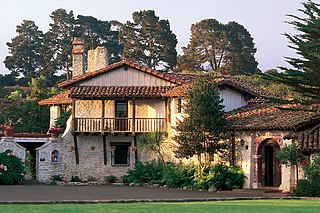
Monterey is a city located in Monterey County on the southern edge of Monterey Bay on California's Central Coast. Founded on June 3, 1770, it was the capital of Alta California under both Spain and Mexico. During this period, Monterey hosted California's first theater, public building, public library, publicly funded school, printing press, and newspaper. It was originally the only port of entry for all taxable goods in California. In 1846 during the Mexican–American War, the United States flag was raised over the Customs House. After California was ceded to the U.S. after the war, Monterey hosted California's first constitutional convention in 1849.

The Presidio of San Francisco is a park and former U.S. Army military fort on the northern tip of the San Francisco Peninsula in San Francisco, California, and is part of the Golden Gate National Recreation Area.
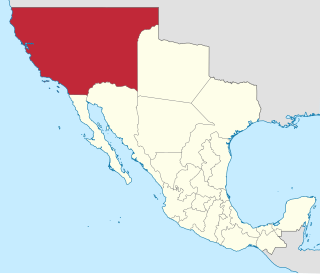
Alta California, also known as Nueva California, among other names, was a province of New Spain, formally established in 1804. Along with the Baja California peninsula, it had previously comprised the province of Las Californias, but was split off into a separate province in 1804. Following the Mexican War of Independence, it became a territory of Mexico in April 1822 and was renamed "Alta California" in 1824. The claimed territory included all of the modern US states of California, Nevada and Utah, and parts of Arizona, Wyoming, Colorado and New Mexico. In the 1836 Siete Leyes government reorganization, the two Californias were once again combined into a single departamento. That change was undone in 1846, but rendered moot by the U.S. military occupation of California in the Mexican-American War.

Human history in California began when indigenous Americans first arrived some 13,000 years ago. Coastal exploration by Europeans began in the 16th century, and settlement by Europeans along the coast and in the inland valleys began in the 18th century. California was ceded to the United States under the terms of the 1848 Treaty of Guadalupe Hidalgo following the defeat of Mexico in the Mexican–American War. American westward expansion intensified with the California Gold Rush, beginning in 1848. California joined the Union as a free state in 1850, due to the Compromise of 1850. By the end of the 19th century, California was still largely rural and agricultural, but had a population of about 1.4 million.

John Drake Sloat was a commodore in the United States Navy who, in 1846, claimed California for the United States.
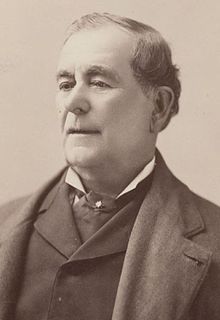
Don Mariano Guadalupe Vallejo was a Californio general, statesman, and public figure. He was born a subject of Spain, performed his military duties as an officer of the Republic of Mexico, and shaped the transition of Alta California from a territory of Mexico to the U.S. state of California. He served in the first session of the California State Senate. The city of Vallejo, California is named for him, and the nearby city of Benicia is named for his wife.

A presidio is a fortified base established by the Spanish in areas under their control or influence. The term is derived from the Latin word praesidium meaning protection or defense.
Luis Antonio Argüello was the first Californio (native-born) governor of Alta California, and the first to take office under Mexican rule. He was the only governor to serve under the First Mexican Empire and also served as acting governor under the subsequent provisional government, which preceded the First Mexican Republic.
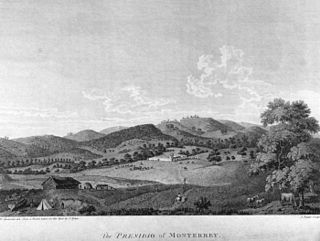
The Presidio of Monterey (POM), located in Monterey, California, is an active US Army installation with historic ties to the Spanish colonial era. Currently, it is the home of the Defense Language Institute Foreign Language Center (DLI-FLC). It is the last Presidio in California to have an active military installation.

The Defense Language Institute (DLI) is a United States Department of Defense (DoD) educational and research institution consisting of two separate entities which provide linguistic and cultural instruction to the Department of Defense, other Federal Agencies and numerous customers around the world. The Defense Language Institute is responsible for the Defense Language Program, and the bulk of the Defense Language Institute's activities involve educating DoD members in assigned languages, and international personnel in English. Other functions include planning, curriculum development, and research in second-language acquisition.

Californios are Hispanic people native to the U.S. state of California. California's Spanish-speaking community has resided there since 1683 and is made up of varying Criollo Spaniard, Mestizo, and Indigenous Californian origins. Alongside the Tejanos of Texas and Neomexicanos of New Mexico and Colorado, Californios are part of the larger Chicano/Mexican-American/Hispano community of the United States, which has inhabited the American Southwest and the West Coast since the 16th century.
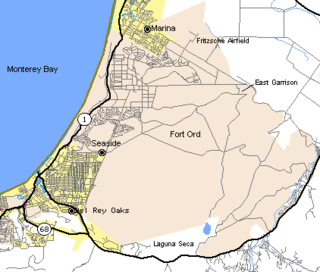
Fort Ord is a former United States Army post on Monterey Bay of the Pacific Ocean coast in California, which closed in 1994 due to Base Realignment and Closure (BRAC) action. Most of the fort's land now makes up the Fort Ord National Monument, managed by the United States Bureau of Land Management as part of the National Conservation Lands, while a small portion remains an active military installation under Army control designated as the Ord Military Community.

José Antonio Estudillo was a Californio and an early settler of San Diego, California when California was part of New Spain.

The Cathedral of San Carlos Borromeo, also known as the Royal Presidio Chapel, is a Roman Catholic cathedral located in Monterey, California, United States. The cathedral is the oldest continuously operating parish and the oldest stone building in California. It was built in 1791-94 making it the oldest serving cathedral in the United States, along with St. Louis Cathedral in New Orleans, Louisiana. It is the only existing presidio chapel in California and the only existing building in the original Monterey Presidio.

Slavery in colonial California began with the systematic enslavement of indigenous Californians. The arrival of the Spanish colonists introduced chattel slavery and involuntary servitude to the area. White colonists from the Southern and Eastern United States brought their systems of organized slavery to California.
The Free Company of Volunteers of Catalonia was a military company of the Spanish Army serving in the Spanish colonial empire.

The Presidio of San Ignacio de Túbac or Fort Tubac was a Spanish built fortress. The fortification was established by the Spanish Army in 1752 at the site of present-day Tubac, Arizona. Its ruins are preserved in the Tubac Presidio State Historic Park.
The 7th California Infantry Regiment was an infantry regiment in the Union Army during the American Civil War. It spent its entire term of service in the western United States, attached to the Department of the Pacific, serving in California and Arizona Territory. They were known as the "Gold Diggers" in reference to the large number of recruits from the California's "Mother Lode" region. Later, they were also called the "Hungry Seventh" for the privations they suffered in Arizona, particularly at Fort Mason. The Regiment included many veterans of the Mexican–American War.

The Sonoma Barracks is a two-story, wide-balconied, adobe building facing the central plaza of the City of Sonoma, California. It was built by order of Lieutenant (Teniente) Mariano Guadalupe Vallejo to house the Mexican soldiers that had been transferred from the Presidio of San Francisco in 1835. The Presidio Company and their commander, Lieutenant Vallejo, were also responsible for controlling the Native Americans living on the northern border of Mexican California.
Vance Barracks at Presidio of Monterey is a military structure that houses students of the Defense Language Institute(DLI). The institute’s foreign language center is the primary tenant organization of the United States Army garrison Presidio of Monterey (POM) located in Monterey, California about 117 miles south of San Francisco, on the Pacific coast of the United States of America.














